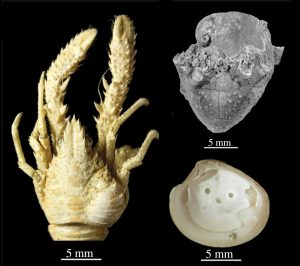Evidence of parasitism in the fossil record has historically received little attention because parasites are small, these soft bodied animals do not fossilize well, and there is an enormous lack of study. However, much more research has been done over the last decade, mostly using traces that parasites leave behind on host organisms that do fossilize.

A few examples include swellings caused by isopod parasites in the gill regions of crustaceans, worm-like animals called trematodes that create pits on the shell interior of clams, and parasitic snails mounted on sea lilies (see figure). Over the last years, several researchers including UA Museums’ Curator of Paleontology Adiel Klompmaker teamed up to synthesize all available evidence of marine parasites over the last 500 million years. They found a remarkable increase in prevalence values for the youngest Era: 5% for the Paleozoic, 4% for the Mesozoic, and 10% for the Cenozoic. In other words, marine parasitism became more common toward the present. Previous studies found that marine biodiversity also increased through time, so the team also studied a possible relationship of parasite commonness with marine biodiversity. The initial results suggest that when biodiversity goes up, so do the number of occurrences of marine parasitism as well as prevalence values. Stay tuned for more research on parasites over the next years.
Do you want to read more? The article was published on Monday September 20 in the journal Philosophical Transactions of the Royal Society B and is freely accessible.
De Baets, K., Huntley, J.W., Scarponi, D., Klompmaker, A.A., and Skawina, A., 2021. Phanerozoic parasitism and marine metazoan diversity: dilution versus amplification. Philosophical Transactions of the Royal Society B 376: 20200366. https://doi.org/10.1098/rstb.2020.0366